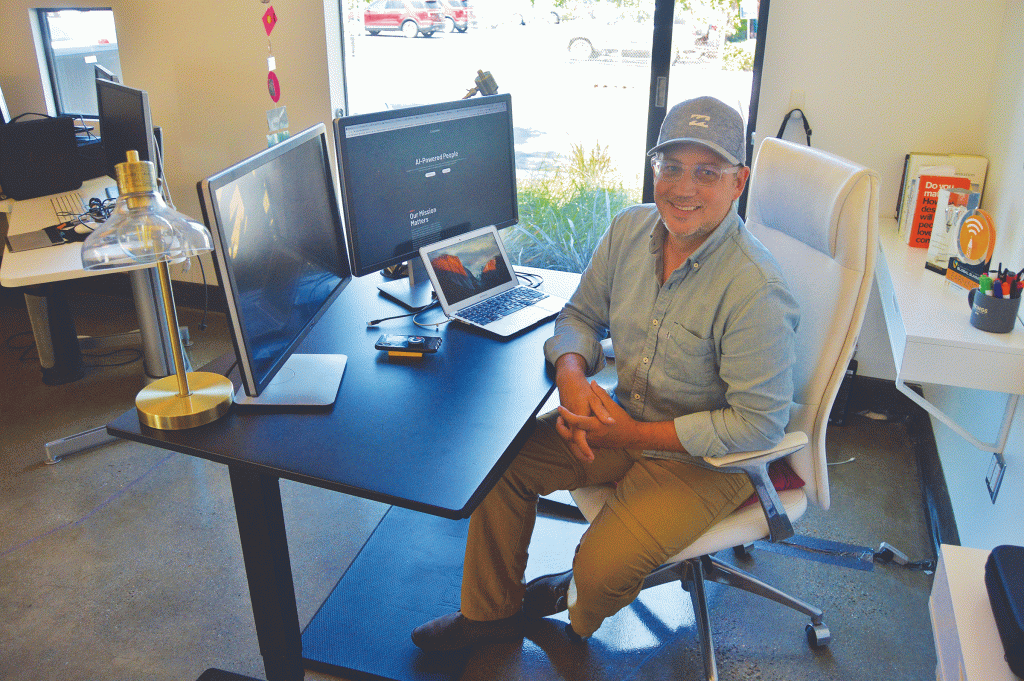Cognixion’s app helps people communicate
IN THIS ARTICLE
- Health Care & Life Science Topic
- Marissa Nall Author
By Marissa Nall Friday, July 26th, 2019

Cognixion CEO Andreas Forsland in his new office on Garden Street in Santa Barbara.
Santa Barbara-based Cognixion is working to give a voice to people with speech-related disabilities.
Called SpeakProse, the newly released app takes advantage of the prevalence of touch screens and cameras on smartphones to help users construct sentences with gestures and eye tracking.
The software aims to provide access to augmented and alternative communication technologies that have been out of reach for many due to high prices and long learning curves.
The company was the product of a Startup Weekend event where the founders pitched a device to help seniors stay in touch with their caregivers, said CEO Andreas Forsland. As the team explored the idea, “We realized that the commonality of all the people we were talking to — communication was the most fundamental problem to be solved, specifically making it more accessible.”
Pivoting to an app instead, it coded preset words and phrases to gestures, “sort of like a digital sign language,” Forsland said. It incorporated input from a variety of fields, such as linguists and speech pathologists, behavioral analysts, occupational therapists, assistive technology clinicians, administrators and insurers.
“One of the insights we learned very early was this idea of core words — the minimum number of words you can use in language to mix and match to say the greatest number of expressions.” With only 20 words, users can create around 5,000 expressions, he said. “With 20 words you can say a lot. With 100 words you can say exponentially more.”
Key to the company’s mission is being able to deliver the tech at a low cost. The free app gives users access to several of the core phrases that enable them to assemble a multitude of sentences. For $8 per month, they can add more words, and for $40 per month, the software teaches the phone’s camera to track eye movements, opening up access for those with mobility challenges.
Most systems cost $3,000 or more, said Julie Blair, a certified speech pathologist who has worked with Cognixion on the development of the product. While insurance pays for it in many cases, it can be an arduous process.
Alternative communication techniques like word boards and pictures have been used in the past as well, but previously required a person to interpret the messages. Instead, app-based eye gaze technologies like Speakprose enable people with conditions like ALS, cerebral palsy, multiple sclerosis, brain or spinal cord injuries and strokes to speak independently and out loud, Blair said.
“It’s a totally different structure to the way that you access it,” she said, describing the system of “cascading sentences” and predictive text.
Cognixion’s approach to the market was also informed by Forsland’s previous experience selling software for Citrix. Rather than relying on slow-moving institutional adoption, the app goes directly to consumers, building a critical mass among individual users before targeting industries like health care and education.
The app launched in June with 30,000 users, he said, and has been adding around 1,000 users per week. Upgrades for eye tracking have slowly started to outpace those for touch users.
“The demand for communication is great and growing, and specifically the demand for eye tracking abilities to control speech is a multiplier,” he said. “The reason why people want a solution like ours is because they know it’s possible, but they don’t have access to it.”
With users in more than 70 countries, the team plans to add other languages down the line.
Future upgrades also hope to add some situational awareness. Geolocation data can clue the phone in to when users are in line for coffee, at a bus stop or at a doctor’s appointment, moving common words and phrases they might need to the top of the queue.
To fund research and development, the company is in the midst of a $3 million seed equity capital raise. Its research office in Canada is also conducting pilot reviews and applying to a federal grant program that helps distribute assistive technologies.
Reducing the time it takes to form a sentence is critical for social interaction where the window to communicate an idea can be very small, said Meaghan Azlein, a former teacher and head of marketing operations for Cognixion.
“It gives those students an opportunity to participate with their peers, which is huge,” she said. “It really enables classroom community.”
Azlein and Blair both noted that it uses common technologies, rather than a specialized device that might mark users out as being different.
Familiar, mainstream emojis also make it easier for users to pick it up quickly, Azlein said.
“So much of the work we have to do with a new technology is a massive amount of training for a huge price tag,” she said.
Cognixion is currently applying to become a provider to Central Coast insurer CenCal Health. Should the contract be approved, it would serve to introduce it to the statewide Medi-Cal system and the federal Medicare system.
While this particular technology is new, CenCal has looked at similar technologies that enable things like glucose monitoring, said Sheila Thompson, quality and credentialing manager for the insurer. Individual therapists in the network often request specific devices, which can then get brought into the fold.
“This new technology meant going and looking at a whole new vendor,” she said, adding that it’s “reflective of the growth of technology, where everything now is an app.”
“This particular technology is relatively new,” said Terri Howell, director of provider services. “What we’re looking for is any tool that will help our members come to a level of health and retain that level of health. Helping an autistic child be able to communicate is just so valuable for the community.”
• Contact Marissa Nall at [email protected].












